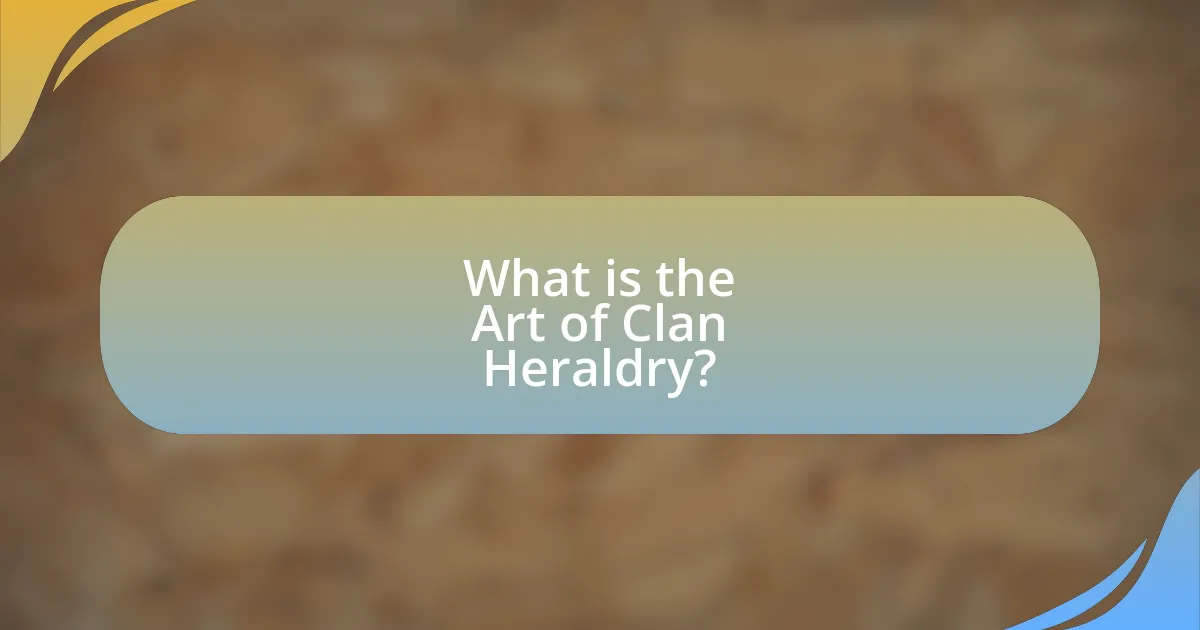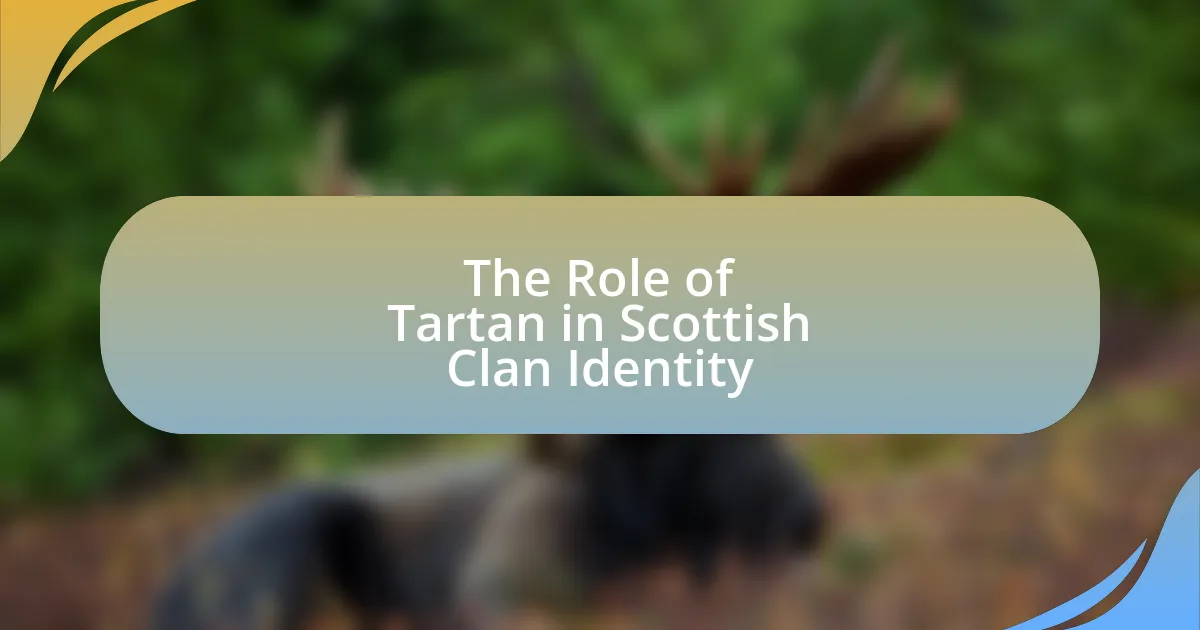The Art of Clan Heraldry encompasses the design and interpretation of coats of arms and heraldic symbols that signify clans, families, or individuals, originating in the Middle Ages as a means of identification in warfare. This practice involves specific colors, shapes, and symbols, each with distinct meanings, governed by heraldic law to ensure uniqueness and adherence to tradition. The article explores the historical origins of clan heraldry, its cultural influences, key components, and the significance of symbols, colors, and patterns in conveying identity and lineage. Additionally, it addresses the importance of clan heraldry in modern society, common misconceptions, and practical tips for understanding and preserving heraldic traditions.

What is the Art of Clan Heraldry?
The Art of Clan Heraldry is the practice of designing and interpreting coats of arms and other heraldic symbols that represent clans, families, or individuals. This art form dates back to the Middle Ages, where it served as a means of identification in battle and a way to convey lineage and status. Heraldry employs specific colors, shapes, and symbols, each with distinct meanings; for example, a lion often symbolizes bravery, while a cross may represent faith. The rules governing heraldry, known as heraldic law, ensure that each design is unique and adheres to established conventions, which helps maintain the integrity and significance of these symbols throughout history.
How did Clan Heraldry originate?
Clan heraldry originated in the medieval period as a system for identifying individuals and groups, particularly in the context of warfare and tournaments. This practice began in the 12th century when knights started to display unique symbols on their shields and banners to distinguish themselves on the battlefield. The use of heraldic symbols became formalized with the establishment of heraldic authorities, which regulated the design and use of coats of arms, ensuring that each clan had a distinct identity. Historical records indicate that the College of Arms in England, founded in 1484, played a significant role in codifying these practices, further solidifying the importance of clan heraldry in representing lineage and status.
What historical events influenced the development of Clan Heraldry?
The development of Clan Heraldry was significantly influenced by the feudal system and the rise of chivalry in medieval Europe. During the 12th century, as noble families sought to establish their identities and claim territories, heraldic symbols became essential for distinguishing allies and enemies on the battlefield. The adoption of coats of arms was formalized through the establishment of heraldic authorities, such as the College of Arms in England in 1484, which regulated the use of heraldry and ensured that each design was unique to a family or clan. Additionally, the Wars of Scottish Independence in the late 13th and early 14th centuries further solidified the importance of clan symbols, as clans rallied under their heraldic banners to assert their loyalty and heritage. These historical events collectively shaped the evolution and significance of Clan Heraldry, embedding it deeply within the cultural identity of clans.
How did different cultures contribute to Clan Heraldry?
Different cultures significantly contributed to Clan Heraldry by introducing unique symbols, colors, and motifs that reflect their values and histories. For instance, Celtic culture influenced heraldry through intricate knotwork and animal symbols, representing strength and loyalty. Similarly, Norse culture contributed through the use of runes and mythological creatures, emphasizing bravery and honor. The blending of these cultural elements created a rich tapestry of heraldic designs, with each clan’s emblem serving as a visual narrative of its heritage and identity. Historical records show that the adoption of heraldic practices in Scotland during the 12th century was heavily influenced by these diverse cultural contributions, leading to the establishment of a distinct heraldic tradition that incorporated various regional symbols and meanings.
What are the key components of Clan Heraldry?
The key components of Clan Heraldry include the shield, crest, supporters, and motto. The shield serves as the primary symbol, displaying unique designs and colors that represent the clan’s identity and history. The crest, positioned above the shield, often features a specific emblem or animal that signifies the clan’s values or achievements. Supporters are figures or animals placed on either side of the shield, symbolizing protection and strength. Lastly, the motto encapsulates the clan’s ethos or guiding principle, often inscribed on a scroll beneath the shield. These elements collectively convey the heritage and significance of the clan within the context of heraldic tradition.
What symbols are commonly used in Clan Heraldry?
Common symbols used in Clan Heraldry include animals, plants, and geometric shapes. Animals such as lions, eagles, and stags often represent strength, courage, and nobility, while plants like thistles and oak leaves symbolize resilience and endurance. Geometric shapes, including crosses and chevrons, convey various meanings related to honor and protection. These symbols have historical significance, as they were used to identify clans and convey their values and heritage, making them integral to the tradition of heraldry.
How do colors and patterns play a role in Clan Heraldry?
Colors and patterns are fundamental elements in Clan Heraldry, serving to convey identity, values, and lineage. Each color, known as tincture, has specific meanings; for example, red symbolizes bravery, while blue represents loyalty. Patterns, such as stripes or checks, further differentiate clans and signify unique traits or historical events associated with them. The use of these colors and patterns is governed by heraldic rules, which ensure that each clan’s emblem is distinct and recognizable, thus preserving the heritage and legacy of the clan. Historical records show that the systematic use of colors and patterns in heraldry dates back to the 12th century, highlighting their importance in medieval society for identification in battle and social standing.
Why is Clan Heraldry important to clans and families?
Clan heraldry is important to clans and families because it serves as a visual representation of their identity, history, and values. Heraldic symbols encapsulate the lineage, achievements, and characteristics of a clan, fostering a sense of belonging and continuity among its members. For instance, the use of specific colors, animals, and designs in a coat of arms can signify particular traits or historical events associated with the clan, thereby reinforcing their heritage. Additionally, clan heraldry plays a crucial role in legal and social recognition, as it often serves as a mark of nobility or status, which can be traced back to medieval times when heraldry was used to identify individuals in battle and tournaments.
How does Clan Heraldry foster a sense of identity?
Clan heraldry fosters a sense of identity by providing distinct symbols and emblems that represent the history, values, and lineage of a clan. These heraldic symbols serve as visual identifiers, allowing members to connect with their heritage and establish a shared community. For instance, specific colors, animals, and designs in heraldry often reflect the clan’s geographical origins, notable achievements, or ancestral traits, reinforcing a collective identity among its members. Historical records indicate that clans used heraldry as a means of asserting their presence and unity, particularly during conflicts, thereby solidifying their identity in both social and political contexts.
What role does Clan Heraldry play in modern society?
Clan heraldry serves as a means of identity and heritage preservation in modern society. It enables individuals and families to connect with their ancestral roots and cultural history through unique symbols and designs that represent their lineage. For instance, many Scottish clans utilize heraldic symbols to foster community ties and promote cultural events, such as clan gatherings and festivals. Additionally, clan heraldry is often employed in branding and marketing, where businesses leverage these symbols to evoke tradition and authenticity, thereby appealing to consumers’ sense of heritage. This dual role of fostering personal identity and enhancing cultural pride underscores the significance of clan heraldry in contemporary contexts.

What are the different types of heraldic symbols?
Heraldic symbols can be categorized into several types, including charges, tinctures, and ordinaries. Charges are the figures or symbols placed on a shield, such as animals, plants, or objects, which represent specific qualities or attributes of the bearer. Tinctures refer to the colors and metals used in heraldry, including specific shades like azure (blue) or gules (red), which convey meaning and hierarchy. Ordinaries are basic geometric shapes, such as crosses or chevrons, that serve as the foundation for more complex designs. These classifications are essential for understanding the visual language of heraldry, which has been used since the Middle Ages to signify lineage, allegiance, and identity.
What are the main categories of heraldic symbols?
The main categories of heraldic symbols are charges, tinctures, and ordinaries. Charges refer to the symbols or images placed on a shield, such as animals, objects, or patterns, which convey specific meanings or represent families. Tinctures are the colors and metals used in heraldry, including gold, silver, red, blue, green, and black, each carrying its own significance. Ordinaries are basic geometric shapes or patterns, like crosses or chevrons, that serve as the foundation for more complex designs. These categories collectively form the essential elements of heraldic design, allowing for the unique identification of individuals and families throughout history.
How do charges, tinctures, and ordinaries differ in heraldry?
Charges, tinctures, and ordinaries are distinct elements in heraldry that serve different purposes. Charges are symbols or images placed on a shield, representing specific attributes or lineage, such as animals, objects, or patterns. Tinctures refer to the colors and metals used in heraldic designs, which include hues like red, blue, and gold, and are essential for differentiating elements and conveying meaning. Ordinaries are basic geometric shapes or patterns, such as crosses or chevrons, that form the foundation of a coat of arms and often signify rank or status. Each of these components plays a crucial role in the overall design and interpretation of heraldic symbols, contributing to the unique identity of a family or organization.
What are the meanings behind common heraldic symbols?
Common heraldic symbols convey specific meanings related to virtues, qualities, or historical significance. For example, a lion typically represents courage and bravery, while an eagle symbolizes strength and nobility. Additionally, a cross often signifies faith, and a shield denotes protection. These interpretations are rooted in historical contexts, where symbols were used to communicate values and lineage, making them essential in the study of heraldry.
How are heraldic symbols created and designed?
Heraldic symbols are created and designed through a systematic process that combines artistic expression with strict rules of heraldry. The design begins with the selection of colors, shapes, and symbols that represent the identity, values, and history of the individual or family. Each element, such as animals, plants, or geometric shapes, carries specific meanings and must adhere to heraldic traditions, which dictate how these symbols can be combined and displayed. For example, the use of specific tinctures (colors) follows the rules established in heraldic law, ensuring that designs are both visually distinct and meaningful. Historical examples, such as the use of lions to symbolize bravery or eagles for nobility, illustrate how these symbols have been consistently applied throughout history, reinforcing their significance in heraldry.
What processes are involved in designing a coat of arms?
Designing a coat of arms involves several key processes, including research, symbolism selection, design drafting, and finalization. Initially, research is conducted to understand the historical and cultural significance of the symbols and colors relevant to the individual or family. This is followed by selecting appropriate symbols that represent values, lineage, and achievements, ensuring they align with heraldic traditions. Next, a draft design is created, incorporating the chosen elements while adhering to heraldic rules regarding composition and color. Finally, the design is refined and finalized, often requiring approval from heraldic authorities to ensure it meets established standards.
How do artists ensure accuracy in heraldic design?
Artists ensure accuracy in heraldic design by adhering to established heraldic rules and guidelines, which dictate the proper use of symbols, colors, and patterns. These guidelines, known as heraldic principles, include specific rules such as the use of tinctures, which are the colors and metals used in heraldry, and the arrangement of charges, which are the symbols placed on the shield. For example, the rule of tincture states that metals should not be placed on metals and colors should not be placed on colors to maintain visibility and distinction. Additionally, artists often reference historical records and existing heraldic registers to verify the authenticity and lineage of the designs they create, ensuring that each element accurately represents the intended family or clan. This adherence to tradition and historical accuracy is crucial in maintaining the integrity of heraldic art.

How can one interpret heraldic symbols?
One can interpret heraldic symbols by analyzing their colors, shapes, and imagery, as each element conveys specific meanings. For instance, colors like gold represent generosity, while blue signifies loyalty. Shapes such as shields indicate protection, and animals often symbolize traits; a lion represents courage, while an eagle signifies nobility. Historical context also plays a crucial role, as many symbols are tied to specific families or regions, reflecting their lineage or achievements. Understanding these elements allows for a comprehensive interpretation of heraldic symbols, revealing the identity and values of the clan or individual they represent.
What are the basic rules for interpreting heraldic symbols?
The basic rules for interpreting heraldic symbols include understanding the colors, shapes, and arrangements used in the design. Colors in heraldry, known as tinctures, have specific meanings; for example, gold represents generosity, while blue signifies loyalty. Shapes such as shields, crosses, and animals convey different attributes or qualities associated with the bearer. Additionally, the arrangement of symbols follows specific conventions, such as the placement of charges (symbols) on the shield, which can indicate hierarchy or importance. These rules are grounded in historical practices of heraldry, which date back to the 12th century, ensuring that each symbol conveys a distinct message about lineage, status, or achievements.
How do you read a coat of arms?
To read a coat of arms, one must understand its components, including the shield, supporters, crest, and motto. Each element conveys specific meanings; for instance, the shield typically displays symbols representing the family’s history, achievements, or values, while the colors and patterns follow heraldic rules that signify various traits, such as bravery or loyalty. The supporters, often animals or figures, flank the shield and can indicate the family’s status or alliances. The crest, positioned above the shield, often symbolizes a particular virtue or characteristic of the family. Lastly, the motto encapsulates the family’s philosophy or guiding principle. Understanding these elements allows for a comprehensive interpretation of the coat of arms, reflecting the family’s identity and heritage.
What resources are available for learning about heraldic symbolism?
Books, online courses, and academic journals are key resources for learning about heraldic symbolism. Notable books include “A Complete Guide to Heraldry” by Arthur Charles Fox-Davies, which provides comprehensive insights into heraldic terms and symbols. Online platforms like Coursera and Udemy offer courses on heraldry that cover its history and symbolism. Additionally, academic journals such as “The Heraldry Society Journal” publish research articles that delve into specific aspects of heraldic symbolism, providing scholarly perspectives and analyses. These resources collectively offer a well-rounded foundation for understanding the complexities of heraldic symbolism.
What are some common misconceptions about Clan Heraldry?
Common misconceptions about Clan Heraldry include the belief that heraldry is solely about family crests, that it is only relevant to nobility, and that it is a static system without evolution. Clan heraldry encompasses a broader range of symbols and designs that represent clans, not just individual families, and it is accessible to all, not limited to the aristocracy. Additionally, heraldry has evolved over centuries, adapting to cultural changes and societal needs, which contradicts the notion that it remains unchanged. Historical records show that heraldic symbols have been used by various social classes and have undergone significant transformations, reflecting the dynamic nature of this art form.
How do myths about heraldry affect its perception?
Myths about heraldry significantly distort its perception by creating misconceptions regarding its historical and cultural significance. For instance, many believe that heraldry is solely a relic of the medieval period, overlooking its continued relevance in modern identity and branding. This misunderstanding can lead to a lack of appreciation for the intricate rules and meanings behind heraldic symbols, which are rooted in centuries of tradition and convey important familial and societal values. Additionally, myths such as the idea that heraldry is only for the aristocracy exclude broader societal engagement, limiting its recognition as a valuable cultural heritage that can be embraced by various groups.
What are the most frequently misunderstood aspects of heraldic symbols?
The most frequently misunderstood aspects of heraldic symbols include their colors, shapes, and the meanings behind specific animals and objects depicted. Many people incorrectly assume that colors in heraldry have universal meanings, while in reality, their significance can vary by region and context; for example, red often symbolizes courage, but its interpretation can differ across cultures. Additionally, the shapes and arrangements of symbols, such as the use of crosses or chevrons, can convey specific familial or territorial claims that are often overlooked. Furthermore, animals like lions or eagles are frequently misinterpreted; while they may represent strength or nobility, the specific breed or posture can indicate different attributes or historical references. Understanding these nuances is essential for accurate interpretation of heraldic symbols.
What practical tips can help in understanding Clan Heraldry?
To understand Clan Heraldry effectively, one should study the specific symbols and colors used in heraldic designs, as each element carries distinct meanings. For instance, colors like blue often represent loyalty, while red signifies bravery. Additionally, examining historical contexts and the lineage of clans can provide insights into the significance of their heraldic emblems. Resources such as heraldic dictionaries and guides can further clarify the meanings behind various symbols and their combinations. Engaging with local heraldic societies or online forums can also enhance understanding through discussions with knowledgeable enthusiasts and experts in the field.
How can one start researching their own family heraldry?
To start researching family heraldry, one should begin by gathering information about their ancestors, including names, dates, and locations. This foundational data can be sourced from family records, historical documents, and online genealogy databases such as Ancestry.com or FamilySearch.org. Once the family tree is established, individuals can consult heraldic authorities or societies, such as the College of Arms in England or the American Heraldry Society, which provide resources and guidance on heraldic symbols and their meanings. Additionally, examining historical texts on heraldry, like “A Complete Guide to Heraldry” by Arthur Charles Fox-Davies, can offer insights into the significance of various emblems and coats of arms associated with specific surnames.
What are the best practices for preserving heraldic traditions?
The best practices for preserving heraldic traditions include maintaining accurate records of heraldic designs, educating communities about their significance, and promoting the use of heraldry in modern contexts. Accurate records ensure that the history and meaning of each emblem are preserved, as seen in institutions like the College of Arms in England, which has documented heraldic achievements since the 15th century. Education fosters appreciation and understanding, encouraging new generations to engage with heraldic symbols. Additionally, integrating heraldic elements into contemporary art, architecture, and branding helps keep these traditions relevant and alive.





